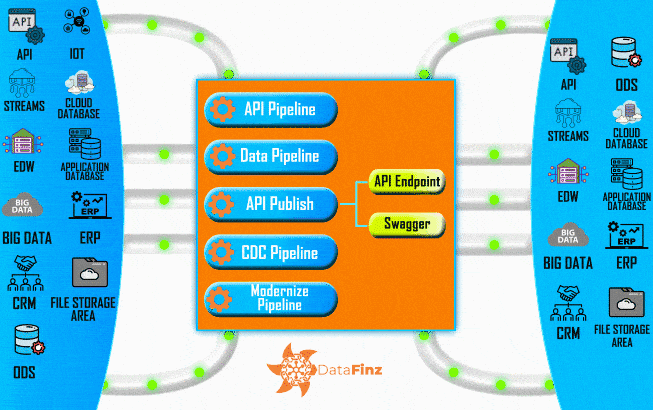In today’s data-driven world, organizations are swimming in a sea of data from various sources. Customer interactions, sales figures, social media metrics, and data from IoT devices are just a few examples of the diverse data landscape businesses must navigate. The challenge lies in effectively integrating data from these different sources to make informed decisions. Enter the data integration solution, a powerful ally for organizations in their quest for data harmony. In this blog, we’ll explore 15 compelling reasons why every organization needs a data integration solution.
1. Data Silos Dissolution: Breaking Down the Barriers
Data silos are the enemy of efficient decision-making. They occur when data is trapped in separate departments or systems, creating barriers to accessing and utilizing valuable information. Data integration systems break down these silos, merging data from various sources to provide a unified view of your operations. This holistic perspective allows you to connect the dots between departments, such as sales, marketing, and customer service, for more coherent insights.
Imagine a scenario in a healthcare organization where patient records are stored separately in various departments like radiology, patient care, and billing. Data integration systems can bring together this data, allowing doctors, nurses, and administrative staff to access comprehensive patient information in real-time. This not only enhances patient care but also simplifies administrative procedures.
2. Real-Time Insights: Staying Ahead of the Game
In the digital era, real-time insights can make all the difference. Data integration solutions enable real-time data updates, ensuring that your organization has access to the most current information. This is particularly valuable when responding to market changes, tracking evolving trends, and staying ahead of your competition.
For instance, consider an e-commerce business that integrates data from its website analytics, inventory management system, and customer feedback surveys in real-time. With this integrated data, they can monitor website traffic, product stock levels, and customer satisfaction as it happens. This ability to react swiftly to low stock levels or negative customer feedback can significantly impact their competitiveness.
3. Enhanced Decision-Making: From Gut Feelings to Data-Driven Choices
Integrated data offers a comprehensive perspective, allowing organizations to make informed, data-driven decisions. By combining data from various sources, you can identify trends, patterns, and correlations that might not be apparent when examining individual datasets. This newfound clarity empowers decision-makers to optimize strategies and maximize results.
Suppose a financial institution integrates data from multiple sources, including transaction records, credit scores, and market data. With this integrated data, they can more accurately assess credit risk, detect fraudulent activities in real-time, and make informed investment decisions. These data-driven choices can lead to higher profitability and risk reduction.
4. Efficiency Gains: Streamlining Your Processes
Efficient data integration can significantly streamline your processes. Instead of manually collecting and consolidating data, data integration solutions can automate these tasks, saving time and resources. This newfound efficiency is particularly valuable for managing large datasets and complex operations.
Consider a manufacturing company that integrates data from production machinery sensors with its inventory management system. With real-time data integration, they can automatically trigger reorders of raw materials when stock levels reach a specified threshold, ensuring uninterrupted production. This automation not only reduces manual effort but also minimizes production downtimes, resulting in cost savings.
5. Holistic Customer Understanding: The Power of Personalization
For businesses, integrating data from different sources helps build a 360-degree view of your customers. This holistic understanding allows you to tailor your products and services to their needs and preferences. By integrating data from in-store sales, online purchases, and customer feedback, you can create personalized shopping experiences, recommend products based on past purchases, and proactively address customer concerns.
Imagine a scenario in the hospitality industry where a hotel chain integrates data from their booking system, customer reviews, and loyalty program. This integrated data enables the hotel to provide personalized services to guests. For example, if a frequent guest prefers a certain room type or extra towels, the hotel can ensure these preferences are met, resulting in higher guest satisfaction and loyalty.
6. Competitive Advantage: Outpacing Your Competitors
The agility gained through data integration can give your organization a competitive edge. With real-time insights, quicker decision-making, and a clearer understanding of your customers, you can outperform competitors. Whether it’s responding to market shifts or adapting to customer preferences, data integration helps you stay ahead of the curve.
Consider two retail businesses, one that utilizes data integration and another that doesn’t. The business with data integration can track inventory levels in real-time, replenishing popular items as soon as they run low. In contrast, the competitor may struggle to keep items in stock, resulting in missed sales opportunities. This competitive advantage is achieved through data integration’s ability to keep businesses agile and responsive to market demands.
7. Error Reduction: Say Goodbye to Inaccuracies
Manual data entry and integration are error-prone processes. Automated data integration significantly reduces the risk of human error, ensuring the accuracy and consistency of data. This is particularly important in industries where precision is paramount, such as healthcare and finance.
In the healthcare sector, patient data integration is critical for reducing errors. For example, when integrating data from various sources like electronic health records and laboratory results, a healthcare provider can ensure that patient information is consistent across systems. This accuracy reduces the risk of medical errors, enhances patient safety, and improves the overall quality of care.
8. Scalability: Ready for Future Growth
Data integration systems are designed to scale seamlessly as your data volumes grow. As your organization expands its operations and collects more data, the flexibility of data integration systems ensures they remain effective.
Imagine a startup that experiences rapid growth in its customer base and data volume. Data integration solutions can seamlessly scale to handle the increasing data influx without major disruptions. This scalability ensures that as the organization grows, its data management remains efficient and adaptable.
9. Data Security: Guarding Your Most Valuable Asset
Data security is paramount in data integration. Robust security measures, including encryption, access controls, and audit trails, protect sensitive information as it moves between different sources. This safeguarding is especially crucial in the age of data breaches and privacy concerns.
In industries like banking and finance, data security is non-negotiable. Integrated data solutions ensure that financial institutions can safely manage customer data, protect transactions, and comply with stringent regulations. Encryption and access controls make it extremely challenging for unauthorized parties to access or tamper with sensitive financial information.
10. Data Governance: Keeping Data in Check
Proper data management and integration incorporate data governance practices to ensure data quality, security, and compliance. This practice is vital in industries with strict regulations, such as healthcare and finance. Data governance helps maintain the integrity of your data and ensures it complies with industry standards.
In the pharmaceutical industry, data governance within integrated data systems is indispensable. Integrated data allows pharmaceutical companies to streamline drug development processes by efficiently managing clinical trial data, ensuring regulatory compliance, and maintaining data quality. This adherence to data governance standards is crucial for both patient safety and regulatory approval.
11. Enhanced Reporting and Analytics: Uncover Hidden Insights
Integrated data provides a solid foundation for in-depth reporting and analytics. These capabilities support the development of reports and dashboards, enabling organizations to derive meaningful insights from their data. Whether you’re tracking sales performance or analyzing customer behavior, integrated data offers a more complete picture.
Imagine a retail chain that integrates data from its point-of-sale systems, e-commerce platform, and customer loyalty program. With integrated data
12. Data Quality Improvement: Ensuring Reliability
Integrated data is cleaner data. Data integration systems often include data transformation features that help clean, normalize, and enrich your data. This data cleaning process involves removing duplicates, correcting errors, and handling missing values. Ensuring data consistency, such as standardizing date formats or unit conversions, is part of data normalization. Furthermore, data enrichment enhances your data with additional information, such as adding geolocation data to customer addresses. The goal is to make your data more reliable and suitable for decision-making.
13. Regulatory Compliance: Meeting Industry Standards
Numerous industries, like healthcare, finance, and retail, are governed by strict regulations regarding data management and protection. Integrated data solutions can help you meet these regulatory requirements more easily. These solutions are designed to support compliance by ensuring data security, access controls, audit trails, and adherence to data governance practices. By integrating your data with compliance in mind, you can reduce the risk of fines, legal issues, and damage to your organization’s reputation.
14. Faster Time-to-Insight: Speeding Up Decision-Making
Integrated data accelerates the time-to-insight, which can be a game-changer for organizations. Time-sensitive decisions, such as responding to market shifts or addressing customer needs, benefit from real-time or near-real-time data integration. The ability to quickly access, analyze, and act on integrated data can significantly impact the speed of decision-making. Organizations that integrate data promptly gain a competitive advantage by being more responsive and agile.
15. Cost Savings: Efficiency in Action
Finally, data integration translates into cost savings. When you streamline data collection and processing, you reduce the need for manual data handling and the associated labor costs. Automation not only minimizes errors but also increases productivity. Additionally, real-time insights empower you to optimize processes, reduce operational costs, and allocate resources more efficiently. Data integration is an investment that offers long-term returns through increased efficiency and reduced operational expenses.
Data Integration, Supercharged by Datafinz
In today’s data-centric landscape, the need for effective data integration has never been greater. Businesses and organizations must seamlessly merge data from diverse sources to unlock their full potential, enabling data-driven decisions, breaking down silos, and enhancing operational efficiency. In this quest for data integration mastery, DataFinz emerges as a powerful ally.
DataFinz streamlines data integration through pre-built connectors, flexible data transformation tools, and real-time capabilities, ensuring your data is always up-to-date. Its scalability and performance monitoring elevate your integration game, while the simplicity and efficiency of DataFinz act as a bridge connecting your data landscape effortlessly. With DataFinz at your side, you’re not just integrating data; you’re maximizing its value and turning it into a strategic asset for informed decision-making. Embrace DataFinz and harness the true potential of integrated data management. It’s the future of data integration, available today.




